Affiliate disclosure: This post may contain affiliate links. Please see our Privacy Policy.
While tapping maples was discovered in the new world, birch trees have been tapped by Nordic peoples for millennia. Birch sap is drunk straight as a health tonic, and it’s also made into birch beer, birch kvass and birch syrup.
I first tasted birch syrup as a sample at our local Vermont farmer’s market. The farmer warned me that it’s not like maple syrup, and you wouldn’t use it on pancakes.
It’s described as being “fruity, spicy, and sometimes reminiscent of molasses or licorice in flavor.” It’s for making spicy-sweet things, like birch syrup roasted carrots or birch syrup sweetened spice cake.
I’ll admit, it did have a bit of spice to it, but I’m still happy with it on my pancakes.
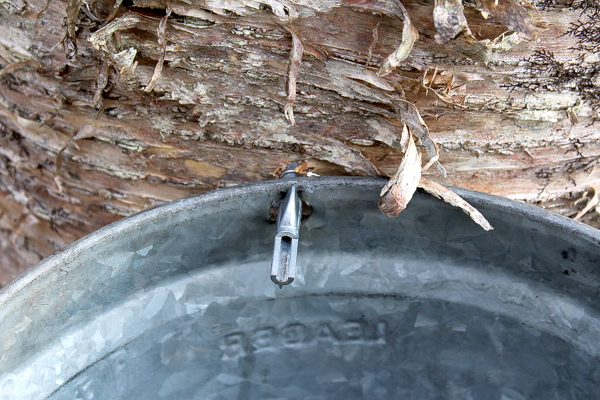
We’ve tapped maples for years, but this is the first year we tapped birch trees. We’re also experimenting with tapping linden trees and ironwood trees. There are lots of different trees you can tap for syrup, dozens in fact.
When to Tap Birch Trees
The sap flow for birch trees is after maples have finished. Maples require freezing nights and warm days to cause the sap to run.
According to Farming the Woods, one of my very favorite permaculture books, Birches begin producing sap when both days and nights are above freezing. Along with above freezing nights, the daytime temperatures need to be consistently above 50 degrees, which usually happens in Mid to Late April in Vermont.
When this happens, the maples stop producing and you can switch all your equipment over from tapping maple trees to birches. This is convenient for maple producers since they can use the same equipment to extend the season. You don’t have to choose between the two.
It’s tricky for gardeners though, because while there’s not much to do during maple season, there’s plenty to do once things warm up enough for birches to start flowing.
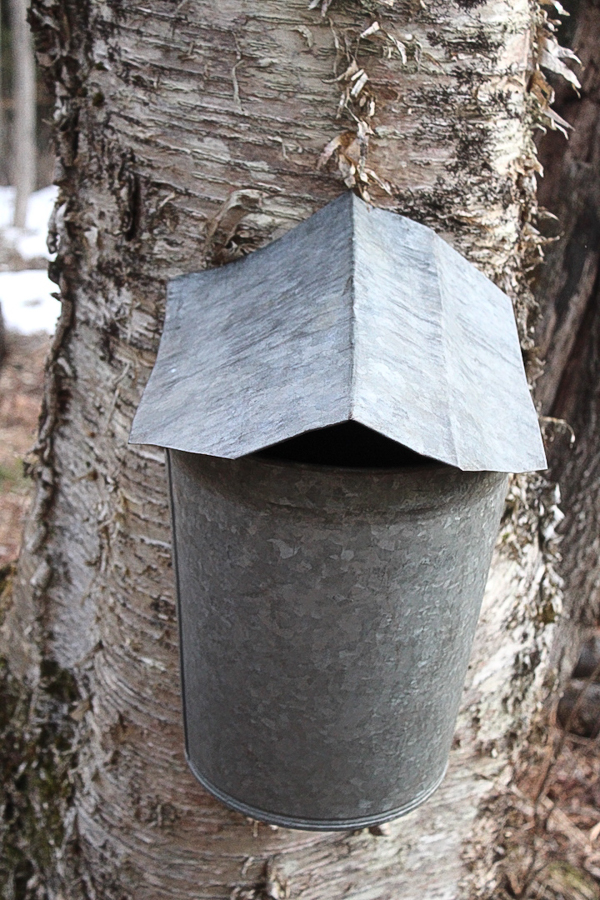
How to Make Birch Syrup
The thing about birch syrup is that it takes a lot of work to make it.
Birches have much less sugar in their sap than maple trees, and while it takes 40 to 50 gallons of maple sap to make one gallon of maple syrup, it takes somewhere between 110 and 200 gallons of birch sap. Farmers are paid back for that extra fuel and boil time, and birch syrup can cost as much as $400 per gallon.
Most people buy it in tiny bottles and use it sparingly.
To make birch syrup, start by tapping birch trees. Any species of birch will do, but it’s said that yellow birches produce sap with the highest levels of antioxidants.
Birch trees need to be at least 8 inches in diameter before they can be tapped, but preferably larger. For maples, they recommend 10 to 12 inches in diameter.
Equipment for Tapping Birch Trees:
- Portable Drill (we use this one)
- 5/16” or 7/16 drill bit (depending on the size of your taps)
- Tree Taps (metal or plastic)
- Syrup buckets or plastic bags
- Some way to cook the sap
You can find a complete tapping kit for maples or birches here.
As the sap begins to run, gather it daily and store it somewhere cool, preferably refrigerated, until you have time to boil. If you don’t keep it cold, it’ll begin to ferment on its own. That’s probably why it was made into fermented beverages in the past, because before refrigeration there was just no stopping it.
Just like with maples, you don’t necessarily need an evaporator to cook birch syrup. There are plenty of ways to make syrup without an evaporator.
A turkey fryer or woodstove works well, or you can rig up a backyard evaporator with steam table pans and cinder blocks. Don’t use anything aluminum, as the birch sap can corrode aluminum.
Regardless of what you use, you’re going to be at it for a long time, so make sure you’re comfortable. Grab a beer and some lawn chairs to enjoy the spring weather as you keep an eye on it.
Birch syrup contains fructose, which is easier to burn than the glucose in maple syrup. It also finishes at a different temperature.
Maple syrup finishes at 7.5 degrees above the boiling point of water. We’re at about 1000 feet above sea level, so that means water boils at around 210 degrees (as opposed to 212 F at sea level). We finish our maple syrup at 217.5 degrees.
Birch syrup finishes somewhere around 225 degrees at sea level or 13 degrees above the boiling point of water. We’ll have to cook it to 223 degrees at 1000 feet elevation. If you have a hydrometer, it should be 66 to 67 Brix.
When the syrup is finished, it can be canned for long-term preservation using the same techniques that you use for canning maple syrup.
Once the leaves begin to appear, it’s time to pull the tap. At this point, the sap will change to be cloudy and sour tasting.
If you’re looking for more specifics and technical details on tapping birches, check out The Sugarmaker’s Companion: An Integrated Approach to Producing Syrup from Maple, Birch and Walnut Trees.
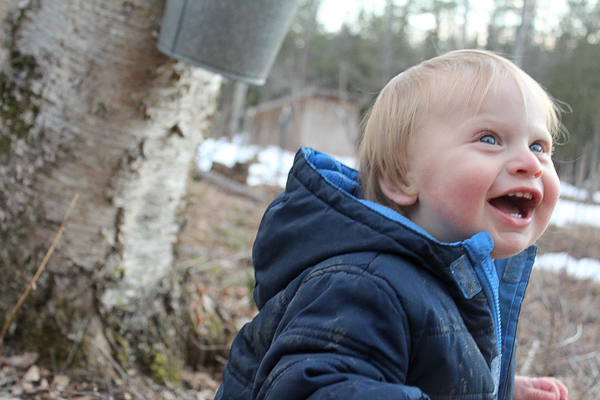
How to Use Birch Syrup
So they say that it’s “not for pancakes,” but I think it depends on your tastes. Most people pour corn syrup on pancakes and don’t give it a second thought, and I’d say that stuff’s not for pancakes.
I’ll take a bit of spice along with my sweet, and I’m happy to pour it on my pancakes. Besides pancakes, it looks great as a topping for this nordic oatmeal.
Similarly, on the sweet side of things, I’d imagine this birch syrup ice cream is tasty, combining a bit of spice and bitterness with a sweet creaminess. The natural molasses flavor likely comes out strong in these birch sap chocolate chip cookies.
This birch syrup pie is basically a birch sweetened egg custard baked into a crust and it looks like a great way to showcase the flavor of birch syrup without much else to distract you. Similarly, it’s front and center in these birch syrup pecan squares.
On the savory side, this spicy-sweet birch candied salmon looks interesting. Clearly, it’s popular with fish because here it is used again in a ginger birch baked salmon.
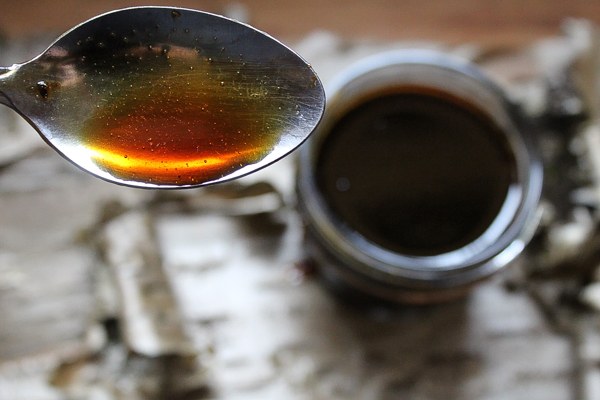
Using Birch Sap (without Boiling for Syrup)
We are making our own birch syrup, but we’re also planning on using the birch sap in other traditional ways. While birch syrup is becoming more popular for home use these days, historically the sap was used rather than investing all that energy to boil it down into syrup.
The simplest way to use it is to simply drink it straight. The tree filters water naturally through its tissues and adds a bit of sweetness and minerals. One company sells it bottled and markets it as a natural electrolyte beverage like coconut water.
A local Vermont company has been making maple sap seltzer for a while now, and they just broadened their line to include carbonated birch sap seltzer. Just birch sap, carbonation and citric acid.
It’s delicious. It tastes just like cream soda to me, but without all the corn syrup sweetness you find in a traditional soda. All the flavor, but just a hint of sweet. It’s only 25 calories for the whole can (compared with 40 calories for maple sap seltzer), so just enough sweet to wake up your tongue, but not enough to overpower the other flavors.
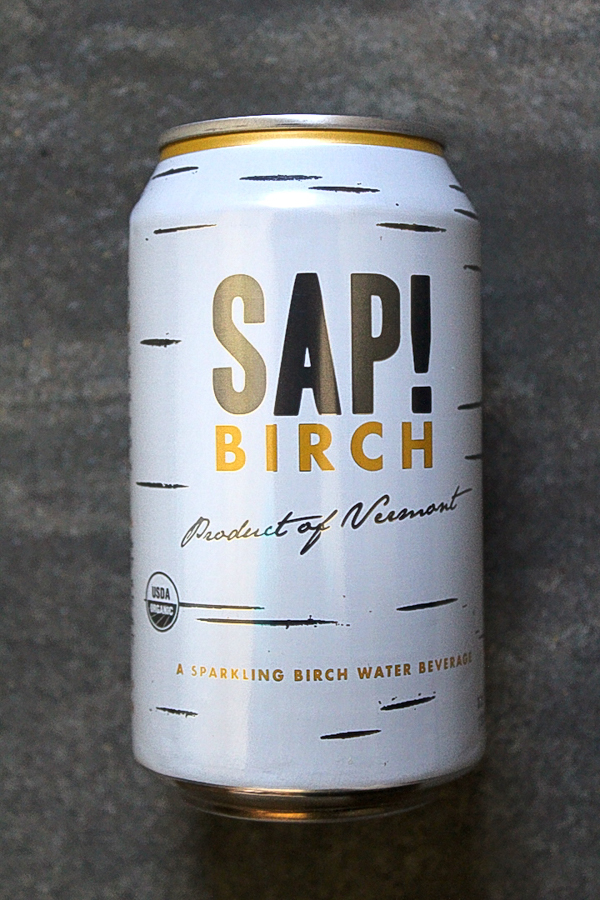
Beyond drinking it straight, it’s often fermented because it’ll naturally ferment on its own without refrigeration. Traditional birch beer contained just that: birch. Birch beer generally includes both birch twigs and sap, along with some kind of sweetener, often sugar or honey.
Once you’ve made birch beer, it’s tasty on its own, or you can make it into a fancy birch beer cocktail.
Birch sap wine is only slightly different, using grape juice concentrate or cane sugar and lemon to add additional sweetness. I’m hoping to try a small batch this spring made with birch sap and birch syrup to double down on the birch-y goodness.
In Russia, birch sap was used to make a traditional fermented drink called birch kvass. A bit of birch sap was mixed with black bread, honey, barley and currant leaves for tannins. It’s a quick 3 to 4-day ferment, just long enough to make it fizzy.
Birch sap is still used medicinally in many countries in Scandinavia and Eastern Europe.
MEDICINAL PROPERTIES OF BIRCH SAP
Birch sap is traditionally used to detoxify the body and to cleanse the liver and kidneys. It’s been used to treat gout, kidney stones and scurvy, and is also promoted as a nutritional supplement for newborns and young children.
The book Backyard Medicine discusses the benefits of birch sap, noting that “Birch sap, birch water, or blood, had a folk reputation for breaking kidney or bladder stone and treating skin conditions and rheumatic diseases. It can be drunk in spring as a refreshing and cleansing tonic, clearing the sluggishness of winter from the system. The fermented sap also makes birch wine and country beers and spirits.”
Yellow birch sap, in particular, is known to have high levels of antioxidants and is sought after as a health tonic.
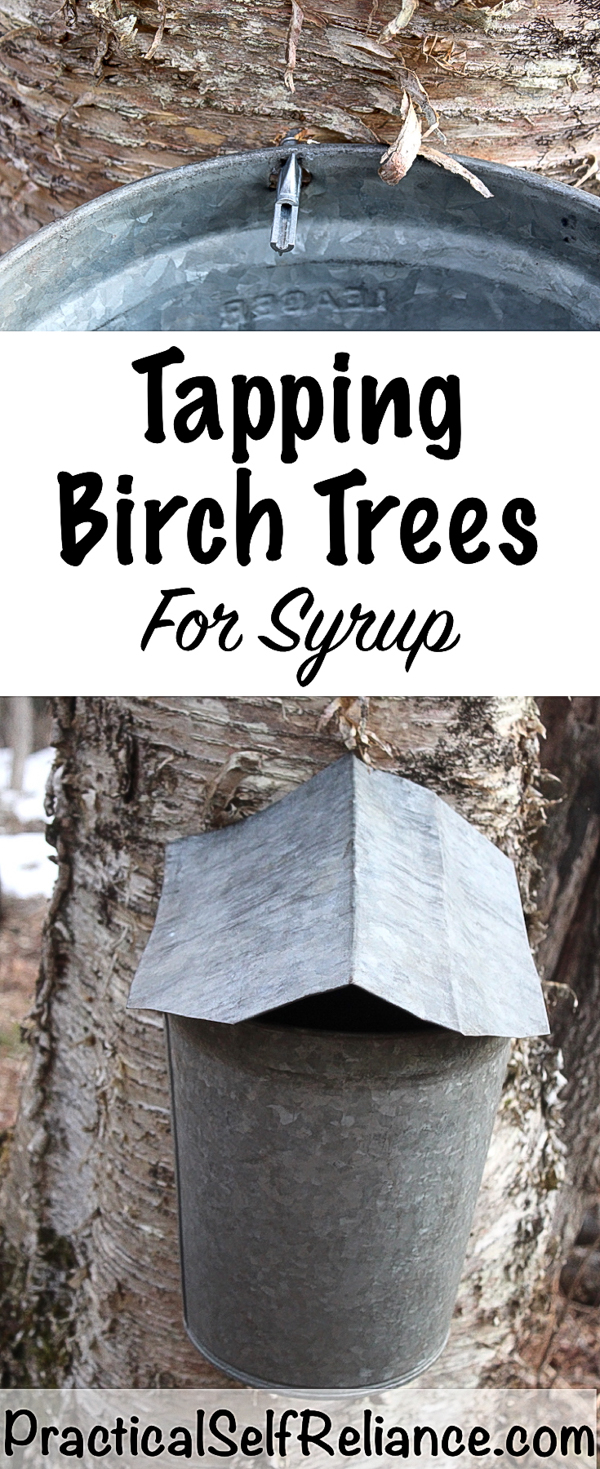
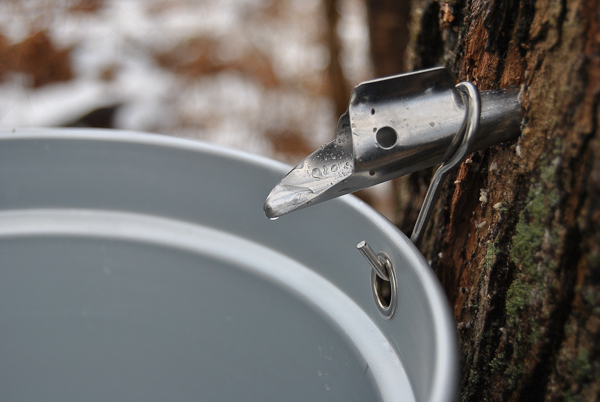
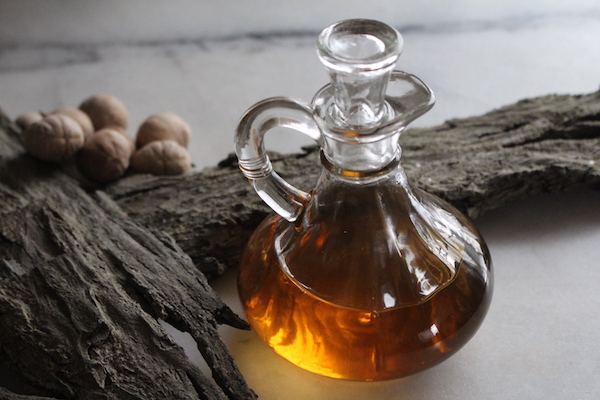
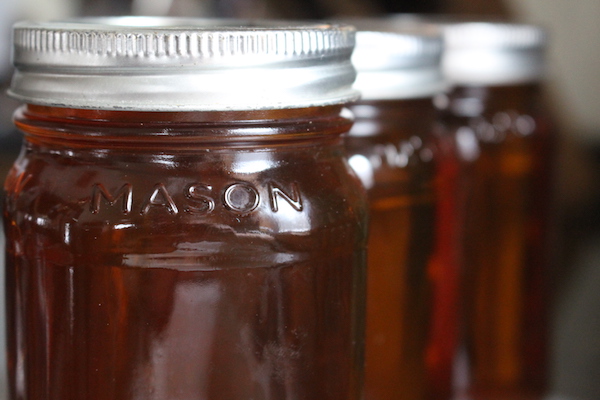
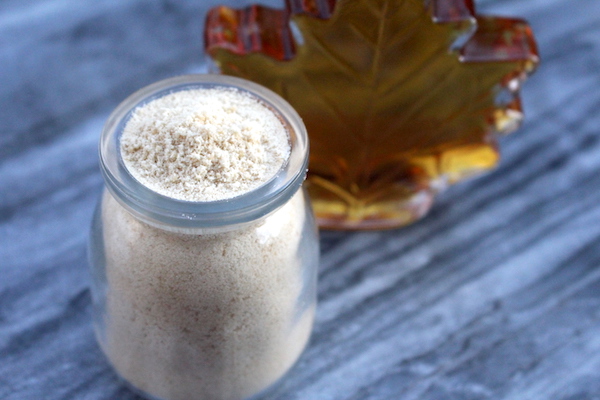
Thanks for this useful information. would love to see a recipe for birch beer.
Should the tap holes be treated in any way when the spigot is removed from the birch?
There is no need to treat the tree after tapping. This article here explains that it could actually do more harm than good. https://s3.wp.wsu.edu/uploads/sites/403/2015/03/wound-sealer.pdf Here is a recipe for the Birch beer https://practicalselfreliance.com/birch-beer/
Very informational. I’ve made birch syrup for 3 years now. Birch has fructose in the sap and needs to be reduced different than maple. I understand fructose will ‘burn’ at temps slightly over 200F. So when reducing, don’t let the temps to exceed 190F to be safe. Bring it to about 60% sugar and reduce the final product between 140-160F.
How should you measure a river birch’s diameter? They have three sections , so I’m wondering even if the individual sections are less than 8″, the overall tree might be mature enough to be tapped.
Thank you for the article! I want to get into tapping trees next spring, and I had no idea you could tap birches until I found this website.
The individual section of the tree that you are tapping needs to be 8 inches.
A friend and I are trying to figure out WHY birch sap flows so much later than maple. I assume in general sap flows to prepare for the production of leaves. Perhaps there is something about the physiology of maples that allows (or requires) freezing night temps? Do you have any information for answering this “why” question? Thanks!
So as far as I know, it has to do with the physiology of the trees. Maple trees respond to air temperature since they’re stimulated to run based on the pressure (ie. warming) within the trunk. Birch trees on the other hand respond to soil temperature because they’re stimulated by pressure/temperature in the roots. The soil warms slower than air, thus the later run. Now as to WHY they are regulated in the roots rather than the trunk, I don’t know…
Now I am keen to try tapping my river birches this year! I’ve no idea if they are big enough, so I’ll have to measure tomorrow.
Hi. My name is Daniel and I am looking for pure birch sap to drink ( therapeutic…) and , I am wonder, if you make cream for skin care with birch sap. Thank you.
What’s the best way to pull the taps out of the trees?
We just tap them on the side of the tap with a rubber mallet and they loosen and can just be pulled by hand.
This is AMAZING! Thank you for sharing!
I am wondering, since I have read of traditional medicine in which you drink the sap (micronutrients and rejuvenation and less sugar), can River birches be tapped? The birches with cinnamon colored bark?
Thanks
All birches can be tapped to the best of my knowledge.
Hello how long does it actually take to tap a birch tree. We have Siberian birch and a few are over 8”.
Does it take a few days? How often should you collect the sap? Do you have any step by step books you would recommend?
Thanks!
By far, the best book on tapping birch trees I’ve found is called “The Sugarmaker’s Companion.” It covers maple, birch and walnut in detail for both the homeowner and commercial producer.
The trees only run for a short season, and up here in Vermont it’s often sometime in April or early May at the latest. In warmer climates, it’d be considerably earlier than that. The trees literally pour with sap, and a 3-gallon bucket needs to be emptied daily, some days twice daily. Sometimes ours would be overflowing by noon.
If they’re not flowing, then you’re tapping either too early or too late. Given you wrote this note at the end of May, I’m guessing you missed the season unless you’re in far northern Canada. Good luck next year!
When I was getting my vehicle serviced to move from VT to Alaska the mechanic said I had to meet their secretary as she was from Alaska. She told me I had to try birch syrup when I got there.
I claimed blasphemy!! I said Vermonters are traditionally cheap so even if birch syrup wasn’t sweet at all, Vermonters would have been cutting it w/ maple sap on bad syrup year.
I was half kidding but after living in the Bush in AK for 9 years, and suffering from tereible birch allergies, and having to buy expensive allergy meds that didn’t really work, a friend just sent me a link from a study that drinking birch sap in the Spring can cure birch allergies. Needless to say I just ordered so taps!!!
https://www.webcenter11.com/content/news/Birch-sap-to-cure-pollen-allergies-Biology-student-presents-findings-at-UAF-research-conference-509993501.html
Good to know, thank you!
Fantastic, I must try this! Actually found your post while looking how to stop the sap flow on my birches that I pruned this winter, thinking it was the right time for that. Warmer weather has arrived and now I have puddles under my birches. At the least I’ll go stand underneath one of the trimmed ends with my mouth open.
Do you happen to have any suggestions for treating those cut ends that are acting like faucets?
I was going to suggest sealing them with a homemade tree sealer made from beeswax that I’d seen at some point, but when I was searching for the recipe I found an article from the University of Washington extension that says sealing tree wounds is actually really harmful. Article here: https://s3.wp.wsu.edu/uploads/sites/403/2015/03/wound-sealer.pdf
My best suggestion is to put a bucket under it and enjoy it, but it looks like sealing it may do more harm than good in the long run.
When would be the right time for birch sap in Northern California?
Honestly, I have no idea. Here, the run is timed to when the soil thaws, days are about 50 degrees and nights are above freezing. But I don’t think you even have frozen soils in winter?
Love your site! Thanks for the information! Easy to read, understand, and follow….
I love your site and have been reading for several weeks the content is true accurate and to the point as are the articles by others cited in the links posted. Keep up the great work and as a result others and myself will continue to be educated in a positive and highly productive manner. Thank You. William Meehan Jessup Pennsylvania
I’m glad you’ve found it helpful, and thank you so much for the encouragement!